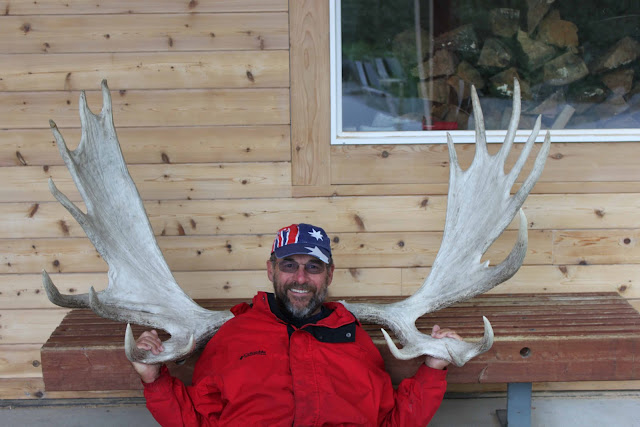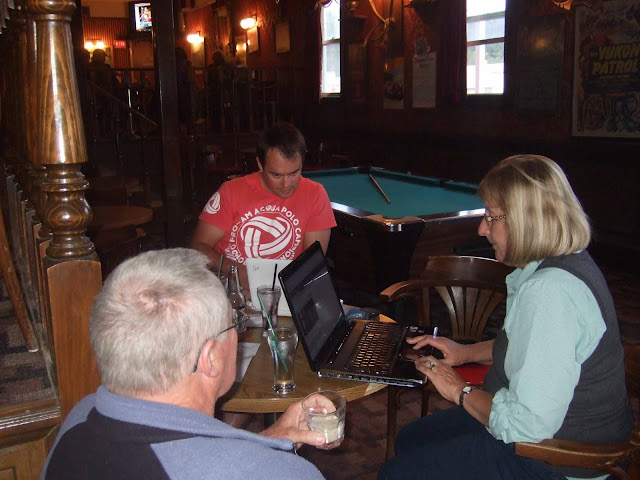When the Australian Double canoe passed us Steve was a different man. Off he went after them and I had a real battle holding on to him. These racing canoes we were up against are 8 meters long, kevlar and weigh less 15 kilos, and very fast. The problem is that because of the huge amount of available space, they are tempted to fill them up with all sorts of unnecessary gear,
Up wind they are a lot of windage, added to the paddlers sitting in a vertical position.
We headed straight into a head wind, that knocked them around and we soon over took them and powered away, with Steve leading the charge.
Getting into Dawson we were able to get a sort of update from our trusty land crew.
We powered on to Eagle, in an attempt to reach there before the 11.15 pm cut out. We also wanted the time to get through customs included in our compullsary 6 hour lay off.
Approaching Eagle again it was bucketing down, freezing rain in our face. Extra incentive was to again find a cabin, or even the B and B the land crew were booked into. The heavy rain had washed out the road into Eagle and we sort of hoped it had been repaired so the crew could meet us.
I again powered ahead, to look for customs, and in the dim light on the shore to my left, there appeared flashing lights. I swung around the ferry pontoons and the customs officer was waiting on the shore just above the mud line. I nudged the shore dug out my passport, swung my legs over the side into the deep mud and promptly fell flat on my face, passport and all.
The Customs Officer said the secret to walking on the mud was to keep taking lots of little steps, "a bit like a duck."
Steve came round the corner and we were able to both press our spot devices just inside the 11.15 time limit.
There was some confusion about the time as the US was one hour behind Canada.
It was still bucketing down and we finished the customs formality and paddled the short distance down past Eagle to the B and B.
The land crew were not there so the road must have been still closed. The river was now very low and we struggled up a steel ladder passed a steel 4 meter high retaining wall.
We did see the customs flash his lights again and wondered if the canoe behind us was in.
The B and B was open, so we helped ourselves to showers, dry beds and attempted to dry some gear.
Rain, rain, rain all night, and it was not a pleasant thought getting back into the kayaks in the morning in the dim light and cold rain.
Survival mode again I thought, We put in a very big day the day before so let us just battle on. Every one is in the same situation, but the rest of them did not sleep in beds.
So off we went again after re-strapping Steves back, into a very miserable morning.
The rain did eventually clear a little and we inquired on the river as we passed cruising paddlers if any other canoes had passed that day. "You are the first we have seen" was the consistent reply.
We passed Circle and again attempted to contact the land crew on the 2 way but no response. They had not been able to get to Circle and in any event the faster water was a good 4 kilometers away down a channel on the other side of the river.
We were now in bear country and required to comply with the local camping regulations which involved camping 100 meters from your food which had to be strung 3 meters off the ground and 3 meters from the trunk of any tree.
Tactically we thought we might again stop early that night and see if the canoe behind passed.
Again we sighted a cabin on the map, and set about running down close to the bank to find it or at least the path that lead to it.
And what a great cabin it was. Fully set up with the basics by the National Park, including a meat safe,
fire, outside dunny and fifty million mosquitoes to keep us company.
meat safe
The view opening to the river was limited, but while we lit the fire cooked dinner and hung out our cloths we took it in turns to watch the river to catch that passing canoe. We saw nothing, but may have missed it.
The cabin was like something out of Ernest Hemmingway.
We slept up in the loft, cooking by the heat of the rising fire.
We left more or less on time the next morning, but noticed the river had risen a lot. Fortunately we had tied our kayaks to the bank.
A day of hard slog through this complex part of the river, we relied on way points we had pre set into the GPS at critical turning points. The river basin was up tp 10 kilometers wide with several channels the fastest up to a meter wide.
Every turn we stared ahead and behind to see if we could see a canoe, with many false alarms
With the river higher we thought there might be some hope of finishing without the extra night on the river, but the river again slowed.
Steve was beginning to get really buggered. We were off the river maps and into the google maps. These maps did not indicate cabins etc, It was impossible to know if the cabins we passed were private or public, so the next two nights would be camping,
Camped again early that night on a gravel bank. Steve lit a big fire out of drift wood. My tent pegs would not hold in the gravel, so I had to tie my stays to stumps off the bank.
In putting up my tent I broke a tent pole, I fixed it by shortening it, but it broke again in the night.
Again it was windy and rainy in the night, I did not get too wet, but my tent in the morning was soaked and we were both beginning to run out of even half dry stuff.
Although it was wet once we got going in the morning, I was quite warm.
The river is full of millions of tons of debris. Trees logs etc. Half way through the next day I was paddling up to what appeared to be a log, and I had to back paddle desperately fast to avoid hitting a cougar swimming from one side of the channel to another. Stunned we both watched it swim to the shore, climb out and dive into the bush. It was some big cat.
Based on last years winning team I was able to count back from the finish, the hours to the finish and mark them on the map.
With about six hours to paddle to the finish, we camped again on a gravel island.
moose
We got away on time, but the six hours did not take into account poor Steve's condition, the slow river and the strong head winds.
If Steve could not paddle any further I was going to tow him home. About an hour after we got going I gaffer taped his right hand to the paddle. He felt much better as it took the weight off his fingers.
A couple of hours before we finished I re did the gaffer tape. Despite the very strong head winds and Steve in obvious extreme pain to Steve's credit he managed to finish all 1600 kilometers under his own steam.

















































